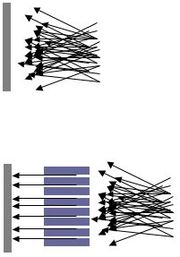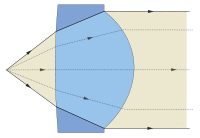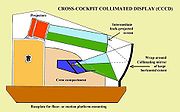
Collimated light
Encyclopedia

Light
Light or visible light is electromagnetic radiation that is visible to the human eye, and is responsible for the sense of sight. Visible light has wavelength in a range from about 380 nanometres to about 740 nm, with a frequency range of about 405 THz to 790 THz...
whose rays
Ray (optics)
In optics, a ray is an idealized narrow beam of light. Rays are used to model the propagation of light through an optical system, by dividing the real light field up into discrete rays that can be computationally propagated through the system by the techniques of ray tracing. This allows even very...
are parallel, and therefore will spread slowly as it propagates. The word is related to "collinear" and implies light that does not disperse with distance (ideally), or that will disperse minimally (in reality). A perfectly collimated beam with no divergence
Beam divergence
The beam divergence of an electromagnetic beam is an angular measure of the increase in beam diameter or radius with distance from the optical aperture or antenna aperture from which the electromagnetic beam emerges. The term is relevant only in the "far field", away from any focus of the beam...
cannot be created due to diffraction
Diffraction
Diffraction refers to various phenomena which occur when a wave encounters an obstacle. Italian scientist Francesco Maria Grimaldi coined the word "diffraction" and was the first to record accurate observations of the phenomenon in 1665...
, but light can be approximately collimated by a number of processes, for instance by means of a collimator
Collimator
A collimator is a device that narrows a beam of particles or waves. To "narrow" can mean either to cause the directions of motion to become more aligned in a specific direction or to cause the spatial cross section of the beam to become smaller.- Optical collimators :In optics, a collimator may...
. Collimated light is sometimes said to be focused at infinity. Thus as the distance from a point source increases, the spherical wavefronts become flatter and closer to plane wave
Plane wave
In the physics of wave propagation, a plane wave is a constant-frequency wave whose wavefronts are infinite parallel planes of constant peak-to-peak amplitude normal to the phase velocity vector....
s, which are perfectly collimated.
Etymology
The word "collimate" comes from the LatinLatin
Latin is an Italic language originally spoken in Latium and Ancient Rome. It, along with most European languages, is a descendant of the ancient Proto-Indo-European language. Although it is considered a dead language, a number of scholars and members of the Christian clergy speak it fluently, and...
verb collimare, which originated in a misreading of collineare, "to direct in a straight line".
Lasers
LaserLaser
A laser is a device that emits light through a process of optical amplification based on the stimulated emission of photons. The term "laser" originated as an acronym for Light Amplification by Stimulated Emission of Radiation...
light from gas or crystal lasers is highly collimated because it is formed in an optical cavity
Optical cavity
An optical cavity or optical resonator is an arrangement of mirrors that forms a standing wave cavity resonator for light waves. Optical cavities are a major component of lasers, surrounding the gain medium and providing feedback of the laser light. They are also used in optical parametric...
between two parallel mirrors, in addition to being coherent. In practice, gas lasers use slightly concave mirrors, otherwise the power output would be unstable due to mirror non-parallelism due to thermal and mechanical stresses. The divergence of high-quality laser beams is commonly less than 1 milliradian, and can be much less for large-diameter beams. Laser diode
Laser diode
The laser diode is a laser where the active medium is a semiconductor similar to that found in a light-emitting diode. The most common type of laser diode is formed from a p-n junction and powered by injected electric current...
s emit less collimated light due to their short cavity, and therefore higher collimation requires a collimating lens.
Synchrotron light
Synchrotron lightSynchrotron light
A synchrotron light source is a source of electromagnetic radiation produced by a synchrotron, which is artificially produced for scientific and technical purposes by specialized particle accelerators, typically accelerating electrons...
is very well collimated. It is produced by bending relativistic electrons around a circular track.
Distant sources
The light from starStar
A star is a massive, luminous sphere of plasma held together by gravity. At the end of its lifetime, a star can also contain a proportion of degenerate matter. The nearest star to Earth is the Sun, which is the source of most of the energy on Earth...
s (other than the Sun
Sun
The Sun is the star at the center of the Solar System. It is almost perfectly spherical and consists of hot plasma interwoven with magnetic fields...
) can be considered collimated for almost any purpose, because they are so far away they have almost no angular size.
Lenses and mirrors

Lens (optics)
A lens is an optical device with perfect or approximate axial symmetry which transmits and refracts light, converging or diverging the beam. A simple lens consists of a single optical element...
es can also produce collimated light from point-like sources.
Collimated displays in flight simulators

Full flight simulator
Full Flight Simulator is a term used by National Aviation Authorities for a high technical level of Flight simulator. Such authorities include the Federal Aviation Administration in the United States and the European Aviation Safety Agency .There are currently four levels of Full Flight...
(FFS), that have specially designed systems for displaying imagery of the Out-The-Window (OTW) scene to the pilots in the replica aircraft cabin.
In aircraft where two pilots are seated side by side, if the OTW imagery were projected in front of the pilots on a screen, one pilot would see the correct view but the other would see a view where some objects in the scene would be at incorrect angles.
To avoid this, collimated optics are used in the simulator visual display system so that the OTW scene is seen by both pilots at a distant focus rather than at the focal distance of a projection screen. This is achieved through an optical system which allows the imagery to be seen by the pilots in a mirror which has a vertical curvature, the curvature enabling the image to be seen at a distant focus by both pilots, who then see essentially the same OTW scene without any distortions.
This is shown diagramatically in more detail in the entry on Full Flight Simulators
Full flight simulator
Full Flight Simulator is a term used by National Aviation Authorities for a high technical level of Flight simulator. Such authorities include the Federal Aviation Administration in the United States and the European Aviation Safety Agency .There are currently four levels of Full Flight...
.

Collimation and decollimation
"Collimation" refers to all the optical elements in an instrument being on their designed optical axisOptical axis
An optical axis is a line along which there is some degree of rotational symmetry in an optical system such as a camera lens or microscope.The optical axis is an imaginary line that defines the path along which light propagates through the system...
. It also refers to the process
of adjusting an optical instrument so that all its elements are on that designed axes (in line and parallel). With regards to a telescope the term refers to the fact that the optical axes of each optical component should all be centered and parallel, so that collimated light emerges from the eyepiece. Most amateur reflector telescopes need to be re-collimated every few years to maintain optimum performance. It is done by simple visual methods such as looking down the optical assembly with no eyepiece to make sure the components are lined up, or with the assistance of a simple laser collimator or autocollimator
Autocollimator
An autocollimator is an optical instrument for non-contact measurement of angles. They are typically used to align components and measure deflections in optical or mechanical systems. An autocollimator works by projecting an image onto a target mirror, and measuring the deflection of the returned...
. Collimation can also be tested using a shearing interferometer
Shearing Interferometer
The shearing interferometer is an extremely simple means to observe interference and to use this phenomenon to test the collimation of light beams, especially from laser sources which have a coherence length which is usually a lot longer than the thickness of the shear plate so that the basic...
, which is often used to test laser collimation.
"Decollimation" is any mechanism or process which causes a beam with the minimum possible ray
Ray (optics)
In optics, a ray is an idealized narrow beam of light. Rays are used to model the propagation of light through an optical system, by dividing the real light field up into discrete rays that can be computationally propagated through the system by the techniques of ray tracing. This allows even very...
divergence to diverge or converge from parallelism. Decollimation may be deliberate for systems reasons, or may be caused by many factors, such as refractive index
Refractive index
In optics the refractive index or index of refraction of a substance or medium is a measure of the speed of light in that medium. It is expressed as a ratio of the speed of light in vacuum relative to that in the considered medium....
inhomogeneities, occlusions, scattering
Scattering
Scattering is a general physical process where some forms of radiation, such as light, sound, or moving particles, are forced to deviate from a straight trajectory by one or more localized non-uniformities in the medium through which they pass. In conventional use, this also includes deviation of...
, deflection
Deflection
Deflection or deflexion may refer to:* Deflection , the displacement of a structural element under load* Deflection , a technique of shooting ahead of a moving target so that the target and projectile will collide...
, diffraction
Diffraction
Diffraction refers to various phenomena which occur when a wave encounters an obstacle. Italian scientist Francesco Maria Grimaldi coined the word "diffraction" and was the first to record accurate observations of the phenomenon in 1665...
, reflection
Reflection (physics)
Reflection is the change in direction of a wavefront at an interface between two differentmedia so that the wavefront returns into the medium from which it originated. Common examples include the reflection of light, sound and water waves...
, and refraction
Refraction
Refraction is the change in direction of a wave due to a change in its speed. It is essentially a surface phenomenon . The phenomenon is mainly in governance to the law of conservation of energy. The proper explanation would be that due to change of medium, the phase velocity of the wave is changed...
. Decollimation must be accounted for to fully treat many systems such as radio
Radio
Radio is the transmission of signals through free space by modulation of electromagnetic waves with frequencies below those of visible light. Electromagnetic radiation travels by means of oscillating electromagnetic fields that pass through the air and the vacuum of space...
, radar
Radar
Radar is an object-detection system which uses radio waves to determine the range, altitude, direction, or speed of objects. It can be used to detect aircraft, ships, spacecraft, guided missiles, motor vehicles, weather formations, and terrain. The radar dish or antenna transmits pulses of radio...
, sonar
Sonar
Sonar is a technique that uses sound propagation to navigate, communicate with or detect other vessels...
, and optical communications
Telecommunication
Telecommunication is the transmission of information over significant distances to communicate. In earlier times, telecommunications involved the use of visual signals, such as beacons, smoke signals, semaphore telegraphs, signal flags, and optical heliographs, or audio messages via coded...
.

